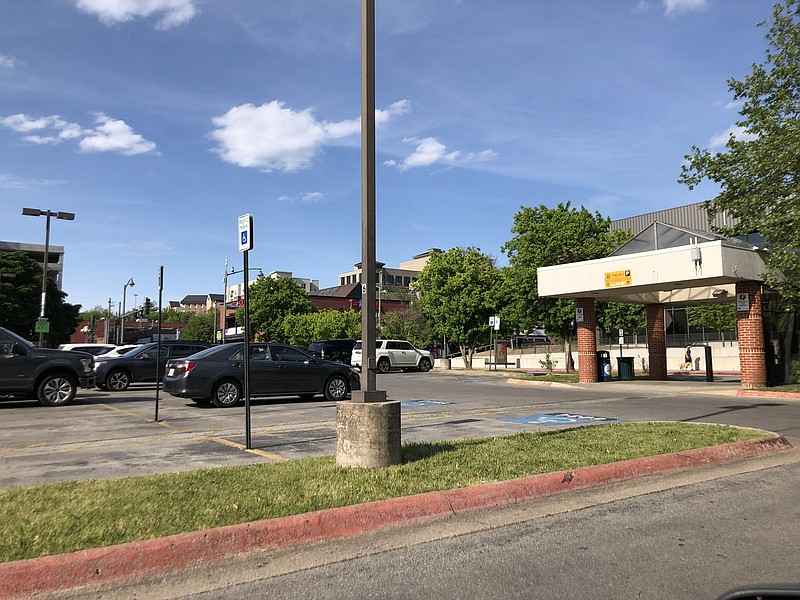FAYETTEVILLE -- It will take a combination of increasing parking supply and deterring people from parking as much to meet downtown's future parking needs, according to a study the City Council saw Tuesday.
Jeffrey Elsey, vice president of Kimley Horn, a planning and design consulting firm in Raleigh, N.C., presented the findings of a study commissioned by the Walton Arts Center and downtown merchants. The group paid $100,000 for the study using private dollars. The consultant team analyzed parking during three weekends: Sept. 22-24 during the showing of "Pretty Woman: The Musical" at the Walton Arts Center; Sept. 30-Oct. 1 during a Razorback football home game; and Oct. 7-8 during a nonevent weekend.
The study area was Arkansas and University avenues to the west, Lafayette Street to the north, Block and St. Charles avenues to the east and Meadow Street to the south. The consultant team counted 2,447 on- and off-street spaces, private and public, within that area. However, about a third of the total were considered inaccessible to the public, meaning the total number of publicly available spaces was 1,519.
From 11 a.m. to 2 p.m. on Sept. 22 while "Pretty Woman" was playing, about 81%, or 1,227, spaces were taken out of the 1,519 considered available to the public, according to the study. Parking supply is considered effectively full at 90% because those last few spaces are difficult for people to find, Elsey said.
That's for today. The consultant team also considered the impact of five major developments planned for downtown: the civic plaza of the arts corridor that will replace the Walton Arts Center parking lot; a hotel planned at the southern end of the civic plaza; a food hall building planned for the northern end of the civic plaza; another hotel potentially at the northwest corner of Dickson Street and West Avenue; and the parking deck under construction.
Those developments likely will result in 42 net new spaces within the study area, with 362 spaces being added and 320 being taken away, according to the study.
The consultant team used a model from the Urban Land Institute, a national nonprofit planning advocacy organization, to project demand once all the new developments are in place. The model bases its numbers on land use, building size, time of day and number of projected customers and employees.
According to the model, about once a month, the study area will need about 500 more parking spaces at peak times. That's based on an effective current supply of about 1,400 spaces and an anticipated peak demand of about 1,900 spaces. Peak times are considered 11 a.m. to 4 p.m. and 5 p.m. to midnight on weekends.
Elsey recommended a combination of tactics to alleviate parking demand. Right now, parking is free 2 a.m. to 2 p.m. daily. The team suggested changing paid parking hours to 8 a.m. to 2 a.m. daily to deter students from parking for long durations and provide more access for customers of nearby businesses. A higher hourly rate for on-street spaces compared to off-street ones also should be considered, according to the study.
Parking pricing should be continuously monitored and adjusted, the team said. The City Council on Tuesday will consider a proposal that would enable the mayor to make changes to parking rates and times. Right now, any changes to downtown parking have to go through the City Council.
A few low-cost and medium-effort changes would have a moderate impact to parking, according to the study. Those efforts include better wayfinding, making private parking more accessible to the public with similar hours and rates as city spaces and increasing paid parking rates and expanding hours.
Creating a new parking structure, in addition to the deck already under construction, would come at a high cost and effort, Elsey said. Finding a suitable spot for a new structure also would be difficult because of limited land availability, and people tend to use spaces less frequently the farther away they are from Dickson Street and West Avenue, he said.
Strategies and actions
Balance parking demand
Better utilize existing parking and distribute demand across the district.
Effectively price public parking
Prioritize parking turnover on-street while using off-street spaces for long-term parking needs.
Further explore citys role in providing parking vs. private sector providing its own
Consider alleviating concerns about future parking by ensuring developments are adequately providing parking, or evaluate if the city should invest in additional facilities.
Build more parking
Does private sector or city provide additional parking?
Source: Kimley Horn
